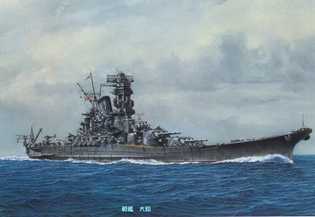戦艦大和 - The Great Yamato!
How many of you readers remember the great battleship, “Yamato?” It has been used in comics and movies as a symbol of Japanese power for years, but I wonder how many people know what the Yamato really was, and stood for.
これを読んでいる皆さんの中で、無敵を誇った戦艦「大和」のことを覚えている方がどれくらいいらっしゃでしょうか。大和は強い日本の象徴として、長い間漫画や映画に登場してきました。しかし、大和の実際の姿、その意味を知っている人は意外に少ないと思います。
First, for armament, it had 9-18 inch guns–very big and powerful; then it had 12-6 inch guns–about 15 centimeters in diameter; and 12-5 inch guns for fighting aircraft attackers. It also had 6 aircraft. It could travel at a speed of about 45 kilometers an hour and had a range of over 10,000 kilometers. It was 250 meters long, 39 meters wide and carried 2500 crew members.
大和には、9-18インチ口径の巨大で強力な大砲が装備されていました。また、12-6インチ口径、直径約15センチの大砲、さらに12-5インチ口径の対空用の大砲も備えていました。大和はまた、6機の戦闘機の発進基地でもありました。 速度は時速45キロ、移動範囲は10000キロにも及びました。大きさは全長250メートル、幅39メートルで、2500人の乗組員が乗り込んでいました。
This great ship took part in many naval battles, but was finally sunk, as a result of air power, southwest of Kyushu. It was a sad end for such a wonderful vessel, but the end was near for the war and the last gallant effort of the ship and its crew was planned and destined for failure. The last battle resulted in the loss of the Yamato, nine other ships and 4000 lives.
数々の海戦で連勝した大和も、九州南西の海上で敵の爆撃を受け遂には沈没しました。雄大な戦艦の無残な最期でしたが、戦争の終結はすでに時間の問題であり、大和とその乗組員の懸命の努力は、いずれにしても報われない運命でした。最後の海戦で、大和は他の九隻の船、四千人の乗組員とともに海底に姿を消したのです。
The huge vessel left for Okinawa on April 7, 1945 with fuel for only a one-way trip. Planners knew that it wouldn’t win, or even have an effect on the war, but the effort was felt to be necessary in the spirit of the samurai that still existed in Japan in those days of war. This feeling of fighting to the end is a thing of the past now, but it surely shows us the spirit of the old people of Japan and we must all consider that spirit as a part of our history.
1945年4月7日、巨大な戦艦が片道分だけの燃料を積んで沖縄を出港しました。作戦の立案者たちは、自分たちの計画が日本の勝利は無論、戦況にさえ何ら影響を及ぼさないことを十分承知していました。しかし、当時の日本にはまだ存在した武士道の精神において、それは必要なことだったのです。最後まで諦めず全力を尽くすという感覚は、今の日本では過去の遺物となってしまいました。しかし、それは確かに昔の日本の精神を示すものであり、その精神を歴史の一部として捉えなければなりません。
You all know of the “Kamikaze” spirit of the fighters of old. This word is now a part of English, but has no significance to “Divine Wind,” as it does in Japan. In English it means “suicide attacker.” After the war, taxi drivers were known as “kamikaze drivers” because of their speed and carelessness in driving.
神風特攻隊については皆さんご存知でしょう。「Kamikaze」は今では英語になっていますが、「神風=神の起こす風」という元の意味は無く、「命知らずの無謀な襲撃者」という意味で用いられます。 戦後、猛スピードで走る乱暴なタクシーの運転手を「カミカゼドライバー」と呼んだりしました。
The spirit of the Japanese was never truly understood by other nations during the war. Today-, this valiant way of life has disappeared and more practical things areconsidered in everyday pursuits. Perhaps it is best, even though we can remember it with special feelings.
戦争中は、この日本の精神は決して外国人に理解されることはありませんでした。今日では、雄々しくあるよりも、日常の実用性が重んじられるようになりました。 確かにそれがベストでしょう。ただ、大和のことを思い出すと特別な思いがします。
